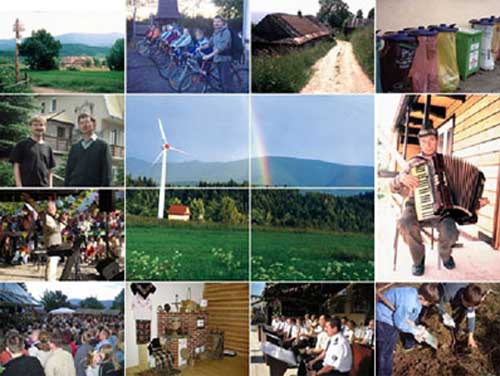ECO VILLAGE

Revitalising the community of Zawoja Przys∏op on the „ Amber Trail”
Key Innovation
The Przysłop centre provides support for nature education looking after the land, renewable energy and other activities.
Problematic background and context
The “Model Eco-Friendly Hamlet” project, carried out by the Equality Association of the Przys∏op Association for Sustainable Development in co-operation with the Barefoot Carmelite Monastery, aims to create a modern hamlet using renewable energy, in which the residents save water and energy, segregate their garbage, take care to create a friendly profile and a clean environment, while bearing in mind their traditions and their roots. On the basis of pre-existing ecological investments (wind power stations, schooltime garbage clean-ups, solar panels and hot air pumps), a plan has been developed to introduce this sort of investment to individual households. The first task is to isolate the most active and courageous “good householders” to decide on the change of heating systems in the homes as well as a thermomodernisation of the buildings. After being shown the first economic advantages of these undertakings, the house-owners inspire others to do similarly.
Solution description
Pupils, parents and teachers of the #4 Elementary School in Przys∏op, seeking to avert its closure, decided to work on the local environment. The school runs the Environmental Education Centre, whose activities include organising courses and ecological education events. The school society gathers ethnographic and historical materials concerning their “small motherland” (albums, slang dictionaries, collections of legends and songs). The Sklepik pod Magurkà was opened up, a place to sell local folk products, souvenirs and publications on the region. The Association’s headquarters is in the school, collecting the most active people who want to solve the problems in their area, and work to improve quality of life while respecting the local cultural and natural heritage (building a water-pump and household compost heaps, creation of a regional council, publication of a mini-dictionary of Babiogórska slang, creation of educational trails, organisation of a festival).
Timeframe
The building of a wind power-station in 1993 caused a change in the hamlet’s course. The residents created the Association for Sustainable Development in the year 2000.
Development phase
Diffusion:
The idea of an ecologicall hamlet was already known in Poland and around the world. The development and transfer of these ideas to other locations is quite possible. The plan of Przys∏op’s leader is to disseminate such activities around the whole region and even create an organisation called “The Small Hamlets of Great Europe.”
Maturity:
The solution was checked and developed. Existing elements such as products by local craftspeople, natural riches, cultural monuments, the Amber Trail route running through the region, the small local school, and the monastery wind power-station were exploited in building and enriching the village’s new image. Now, products are easily accessible, as they are sold in a special shop. Tourists walking the Amber Trail can also visit a newly marked-out path: the Educational Trail and the Trail of Local Chapels, staying the night in one of the agro-tourist hostels, and purchasing souvenirs from one of the ecological shops so as to better recall this region.
Revenue/costs model
The Association’s member find sponsors for the project development. The residents cover the costs of guests who arrive for consultation purposes of a given project. People largely work as volunteers, but the creators of the project and census takers are paid. It is worth emphasising that thanks to the saving of the school, the teachers were allowed to keep working and earning.
Social evaluation
People get satisfaction from being socially engaged – The local residents have some entertainment – The school is maintained – A water-pump was built – Teachers have work – Children can learn in a friendly, intimate atmosphere close to home – The solution’s greatest drawback is that it clearly divides the residents into two groups: active and passive. This can harm rather than unite the society.
Environmental evaluation
The idea of the solution is to promote environmental defence and save water and energy.
Economical evaluation
Promotion of Przyslop gives its residents a chance to earn some extra money – The cost of the ecological installations returns over time, thanks to the use of free energy – Children don’t have to pay for transport to school – The school earns lots of money at the festivals – Some of the active residents sometimes get one-time payments, if, for example, they come up with a project – The residents earn more – The place’s popularity brings tourists
Authors
Barbara Wierzbanowska / Academy of Arts in Cracov / Poland